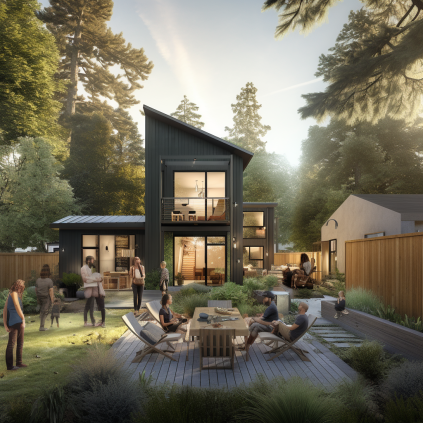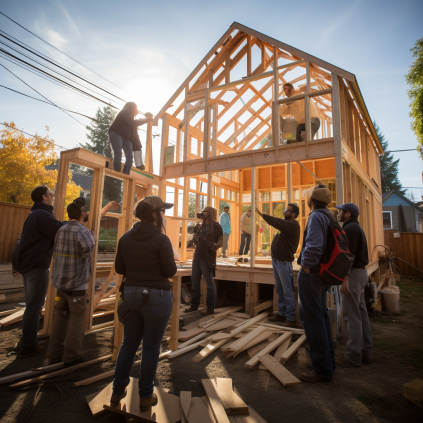Building Your ADU Yourself: Pros and Cons, as well as Navigating Permits
Accessory Dwelling Units (ADUs), or granny flats, in-law suites, or backyard cottages, are an innovative solution to urban congestion and rising housing costs. ADUs - sometimes called granny flats or backyard cottages - are secondary housing units constructed on existing primary home property to offer more affordable living solutions or generate rental income for owners. While DIY ADU building may seem appealing at first, any such endeavor must be carefully evaluated before embarking upon it, and any possible complications surrounding permits before embarking upon any such venture yourself.

What are ADU Homes?
ADU homes are secondary dwelling units located on the same property as a primary residence. They can be separate cottages, converted garages, basement apartments, or additions to an existing home. The concept behind ADU homes is to create additional living spaces that are both functional and flexible. This housing option presents numerous opportunities and benefits for homeowners and communities alike.
ADU Housing: Meeting Diverse Needs
The versatility of ADU homes allows them to cater to a wide range of housing needs:
- Multigenerational Living: ADU homes provide a practical solution for accommodating extended families while maintaining privacy and independence.
- Rental Income: Homeowners can benefit from ADU units by renting them out and generating supplemental income to offset mortgage costs or other expenses.
- Affordable Housing: ADU housing addresses the affordability crisis in urban areas. These units offer a more cost-effective living option without extensive new developments.
- Aging in Place: ADU homes can serve as a comfortable and accessible living space for older adults, allowing them to age in place while staying close to their families.
ADU Homes and Community Planning
As the demand for housing continues to rise, ADU homes have caught the attention of urban planners and policymakers. They offer an opportunity to increase housing density without significantly altering the neighborhood's character. By utilizing existing space and infrastructure, ADU housing minimizes the strain on resources and infrastructure while offering a sustainable way to meet housing demands.

All About Accessory Dwelling Units (ADUs)
Accessory Dwelling Units, commonly known as ADUs, are secondary housing units found on the same property as a main house. These versatile ADU types, such as basement ADUs or accessory apartments, allow homeowners to maximize their property's occupancy potential. ADUs are independent residences, accommodating various living arrangements, including rental housing or multigenerational living. While regulations on ADUs vary from state to state and from residential areas to urban environments, homeowners need to navigate local laws when building an ADU. Whether creating an accessory apartment or an unpermitted ADU, ADUs contribute to addressing housing needs and present innovative solutions for homeowners.
Pros of Constructing an ADU by Yourself
Cost Savings
One of the main draws of DIY construction is cost savings. By managing it yourself, you could reduce labor expenses while tailoring a budget that best meets your financial requirements.
Personalization
Building an ADU yourself provides the unique opportunity to tailor the space to meet your needs and design aesthetic preferences, from optimizing layouts selecting materials, and adding features that reflect your aesthetic.
Learning Experience
Undergoing a construction project can be an incredible educational experience, from honing your construction skills to understanding design and zoning regulations; taking part can yield invaluable knowledge.
Pros and Cons of Building an ADU by Yourself
Time and Effort
DIY projects demand both an investment of your time and energy - from planning, designing, and procuring materials to actual construction - you must be prepared for an extensive time commitment in planning and design, procuring materials, and physical structure.
Complexity
Construction can be complex, and errors can have costly repercussions. Without enough experience on staff, subpar artistry could result in safety hazards or legal disputes further down the road.
Navigating Building Codes and Permits
Navigating local building codes and permits can be daunting; any misstep could result in fines, delays, or having to undo parts of your project altogether.
Navigating Permits for an ADU
Understanding the permit process before undertaking your DIY ADU build project is critical; prioritizing this phase ensures success!
- Research Zoning Laws: Check with local zoning ordinances to see whether ADUs are permitted on your property, as some areas have restrictions regarding size, design, and usage that must be observed for ADUs to operate legally.
- Building Permits: Before embarking on any construction project, building permits may be needed, which require you to submit construction plans and specifications with detailed construction plans for approval by local building departments and safety codes and regulations.
- Accessory Structure Permits: In some areas, ADUs fall under the category of accessory structures; for this purpose, separate permits might be needed for plumbing, electrical, and other utilities that serve the unit.
- Environmental Permits: Depending on your location, ecological permits might be needed to ensure that an ADU won't harm the local ecosystems.
- Historical Districts: If your property lies within a historical district, additional permits and restrictions might apply to maintain its authenticity and preserve the area's character.
Building an ADU (auxiliary dwelling unit) with your hands has advantages and challenges. The apparent upside is that you have the opportunity to create a custom living space without having to pay for expensive labor. However, it is essential to remember the total amount of time, energy, and complexity that the task will demand of you. Resources such as navigating the local regulations, obtaining permits, and anticipating any legal wrangles are vital to consider when beginning such an undertaking. Taking into account the necessary steps to undertake such a project will go a long way towards maximizing the value of your efforts while minimizing any potential pitfalls.

Are You Considering Constructing an Accessory Dwelling Unit (ADU) and need professional Guidance with Sourcing All Necessary Permits, Perfectly Executing the Design, or Competently Executing the Construction? Reach Out To Parceloop Right Away! Our team of experts comprehends all aspects of ADU projects. It will be able to deliver constructive advice - contact us immediately so that our service can help you accomplish the dream of developing a successful additional living space!